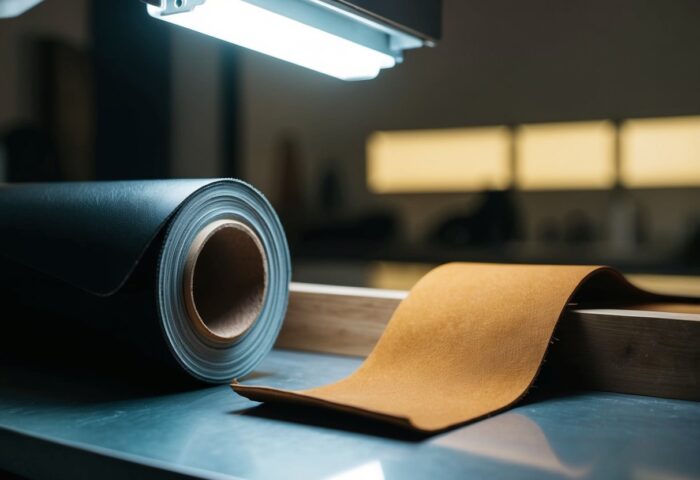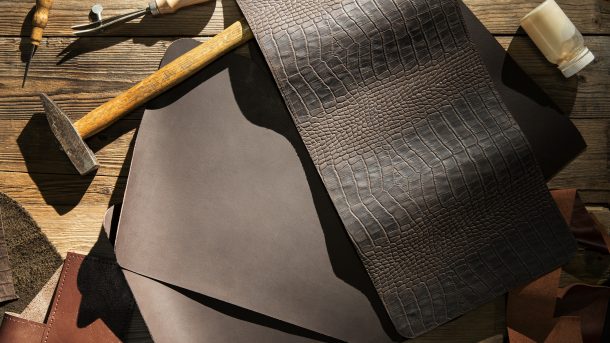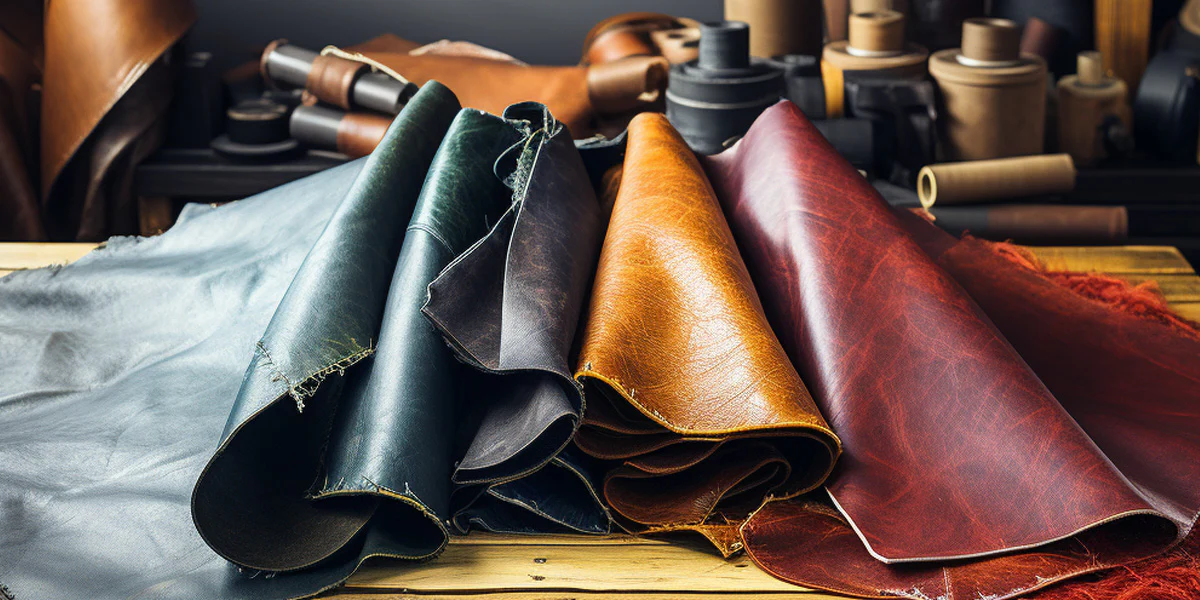A common substitute for genuine leather is synthetic leather, sometimes known as vegan or faux leather. Polyvinyl chloride (PVC) and polyurethane (PU) are among the materials used to make it.
Because it appears like real leather but costs less, fake leather is popular. Additionally, you have additional choices for colour and texture.
Here is a brief summary of typical kinds:
- PU Leather: This flexible and soft material is made of polyurethane.
- Although PVC leather: is stronger, it may feel more rigid.
- Piñatex: A newer variant made from pineapple leaves.
- Muskine: Made from mushroom fibers.
Advantages:
- Affordable: Save money and look stylish.
- Easy care: wipe clean without much hassle.
- Environmental friendliness: some species are more sustainable.
Disadvantages:
- Durability: May not last longer than real leather.
- Impact on the environment: Certain production techniques may be hazardous.
Although they can have a bigger environmental impact, plastics like PVC and PU are recognised to simulate the feel and appearance of genuine leather. As technology develops, more environmentally friendly options are available through Piñatex and Muskin.
Types of synthetic leather
There are numerous varieties of synthetic leather, each with its own materials and manufacturing processes. The four primary forms of leather covered in this section are silicone, bio-based leather, polyurethane (PU) leather, and polyvinyl chloride leather. Benefits and uses for common items vary depending on the type.
Polyurethane (PU) Leather
One of the most often used varieties of artificial leather is PU leather. It is created by applying a layer of polyurethane to a fabric, typically polyester. It imparts a feel and appearance similar to skin.
Due to its softness and flexibility, PU leather is frequently used in furniture, fashion, and automobile interiors. In addition, it is less expensive than genuine leather. PU leather has the advantage of being more breathable than PVC leather. It might, however, wear out over time and not be as resilient as other kinds. PU is a fantastic option if you want something that closely resembles real leather without going over budget.
Polyvinyl chloride (PVC) Skin/Leather
Another popular kind of synthetic leather is PVC leather. This covers the application of PVC as a base coating for fabrics. Because of its extreme durability and water resistance, this imitation leather is appropriate for outdoor furniture and boat seating.
Its resilience to all weather situations is one of its best qualities. The drawback is that compared to PU leather, this kind is less breathable, making it potentially unsuitable for apparel. It is crucial to understand that the chemicals used in the creation of PVC leather may make it less environmentally friendly.
Silicone Skin/Leather
An increasingly environmentally friendly substitute is silicone skin. It is composed of chemicals based on silicon that have a remarkable array of characteristics. The silicone skin is easy to clean, UV resistant, and incredibly durable.
This kind is ideal for upholstery and automobile interiors because it is also very breathable. Although less prevalent, its durability and environmental advantages are making it more and more desirable. Silicone might be for you if you need something durable and are concerned about sustainability.
Biological Skin/Leather
Biological skins are gaining attention due to the use of renewable resources. These leathers use materials such as corn, apple or mushroom waste to create a leather-like material, making them a more sustainable option.
This type is still relatively new, but is making waves thanks to its reduced environmental impact and innovative manufacturing methods. They may not be as widely available, but they are perfect for those who want to support environmentally friendly products. Although not as durable as traditional options, bio leather is a unique option on the market.
Manufacturing process
Creating artificial leather involves a fascinating journey from the raw materials to the final product that mimics real leather. You will examine the materials used, how they are transformed and the finished product.

Materials used
Artificial leather usually starts with plastic materials such as polyurethane (PU) or polyvinyl chloride. These materials are chosen for their flexibility and durability. PU is often preferred for clothing because it is softer, while PVC is stronger, making it ideal for outdoor furniture and items exposed to the weather.
To assist achieve the appropriate thickness and texture, these materials are mixed with additional fillers like cloth or foam. The coating is long-lasting because the fabric’s basis is often cotton or polyester. Because of the range of textures and finishes produced by this combination, imitation leather is a flexible option for numerous applications.
Development and treatment
The manufacturing process of artificial leather usually begins with coating the fabric base with liquid polyurethane or polyvinyl chloride. This can be done in a number of ways, such as wet or dry processing. In wet processing, a liquid material is poured onto the fabric and then dried using heat to create a flexible and durable layer.
The coated material is mechanically processed to give the desired texture and appearance. Techniques such as embossing are used to make the surface look like real leather. During this step, the patterns are pressed onto the material, giving different finishes such as smooth, pebbled or grained.
Finishing works
After the coating and texturing steps, artificial leather receives a finish to improve its appearance and performance. To get the required colour, pigments and dyes are used. Additional treatments, such matte or glossy coatings, are applied to certain materials.
To improve their usability, these artificial leathers can also be treated to increase resistance to factors such as UV light or water. Although they are not as breathable as real leather, the treatment helps make them more durable and wear-resistant. The final product is then ready for a variety of uses, from fashion to furniture, offering a cruelty-free and cost-effective alternative to real leather.
Properties of Synthetic leather
Synthetic leather is known to be versatile and durable. It has many advantages, such as being easier to maintain and offering a variety of textures and looks. All these features make it a popular choice for both fashion and home use.
Durability factors
When it comes to durability, faux leather is built to last. Some types, such as PU leather, are coated with wear-resistant coatings. This feature allows them to be used every day, whether it’s on your couch or in your car. While it may not last as long as natural leather, the durability of synthetics means it resists spills and stains quite well.
Artificial leather does not fade and flake as readily in the sun as real leather does. It is therefore perfect for spaces that receive a lot of natural light. Water resistance is another feature of many synthetic leathers. This is helpful for things that might frequently come into contact with wet circumstances, such boots or jackets.
Care and maintenance
Caring for artificial leather is quite simple. You don’t need special oils or conditioners like you do with real leather. A simple wipe with a damp cloth usually helps to remove everyday spills and dust. If there is a strong stain, you can clean it with mild soap and water.
With regular cleaning, artificial leather can keep it looking new for a long time. Unlike natural leather, it will not cause patina, so your care is designed to keep it looking fresh. Do not use harsh chemicals or abrasive cleaners as they may scratch or damage the surface.
Appearance and texture
The purpose of synthetic leather is to replicate the texture and appearance of real leather. At first glance, it may be hard to tell it apart from genuine leather due to its similar grain and texture. Because of this, it is favoured in industries where aesthetics are crucial, such as fashion and furniture design.
Fake leather comes in a range of hues and sheens, from glossy to matte. More imaginative design options are made possible by this variant. Synthetic leathers appear uniform across vast surfaces because they are frequently more consistent in colour and texture than real leather.
Environmental impact
When considering faux or vegan leather, it’s important to be aware of its environmental impact. Both synthetic and real leather have great effects, but they differ in key ways.
- Synthetic leather uses petrochemicals such as polyurethane (PU) and polyvinyl chloride (PVC). These materials require energy-intensive processes that contribute to pollution and greenhouse gas emissions.
- Genuine leather, as a byproduct of cattle farming, contributes to deforestation and greenhouse gases. Cattle farming is a major factor in deforestation, harming biodiversity and increasing fire risk.
- Chemicals used to tan leather can harm soil, water and air.
- Material Impact Synthetic leather uses petrochemicals, energy-intensive production, less deforestation Real leather Cattle farming promotes deforestation, high greenhouse gases, harmful chemicals during tanning
Although some producers of synthetic leather are working towards sustainability, resource use is still high. You can choose materials more wisely if you are aware of their consequences.
- Alternative options are emerging, such as lab-grown skins, which may offer a more sustainable future. These innovations could provide green choices that reduce environmental damage.
Synthetic leather in fashion
Synthetic leather is playing a big role in the fashion world, offering an affordable and animal-friendly alternative to natural leather. It is widely used for clothing, footwear and various accessories.

Clothes
Because it can replicate the rich texture and appearance of genuine leather, imitation leather has grown in popularity as a material for apparel. Synthetic coats and jackets are not only fashionable but also water and wind resistant, which is useful in erratic weather conditions. It can be found in skirts and pants in addition to jackets, adding a stylish touch to your clothing. Clothing made of synthetic leather is also typically lighter, which makes it more comfortable and easier to move around.
Footwear
The footwear industry has seen significant growth in the use of synthetic leather. It is frequently utilised to make stylish and long-lasting shoes. It can be used to create stylish shoes or casual trainers. The primary benefit is that synthetic leather shoes are easy to maintain in terms of look because they are reasonably easy to clean. Additionally, a lot of manufacturers are choosing synthetic leather because it complements cruelty-free and environmentally responsible fashion trends. The availability of synthetic shoes makes them an appealing option for many, even though their longevity may not be as good as that of natural leather shoes.
Attachments
Synthetic leather is a popular choice for fashion accessories, such as belts, wallets, and handbags. Its adaptability and accessibility are its main draws. A large variety of designs and styles are readily available to fit any event. The fact that accessories made of synthetic leather are more colourful and patterned than those made of conventional leather is something that many people value. Additionally, they are frequently softer, which makes carrying or wearing them more comfortable. Synthetic leather is a useful and fashionable option for accessories, regardless of your preference for traditional or modern styles.
Related Article:
Artificial Synthetic Leather is Everywhere
A Complete Guide About Embossed Leather Hides 2024
Synthetic leather vs natural leather
Choosing between synthetic and natural leather can depend on factors such as cost, ethics and purpose. While synthetic leather is affordable and vegan, natural leather is known for its luxury and durability.
Price comparison
When it comes to price, synthetic leather usually comes out on top as the more economical option. It is often cheaper because it is made from plastic and other artificial materials that are cheaper compared to animal fur. This makes synthetic leather an attractive option for those looking for a leather-like product without the high price tag.
Natural leather, on the other hand, involves a more complex process of obtaining and processing animal hides. This results in a higher price. It is usually more expensive, partly due to the durability and quality of the material. If you’re looking for a long-lasting product and don’t mind the extra expense, genuine leather might be the right choice for you.
Ethical considerations
Ethical considerations can have a big impact on your choice between synthetic and natural leather. Synthetic leather is often considered a cruelty-free alternative because it avoids the use of animal fur, which appeals to those concerned about animal welfare. However, it poses some environmental problems due to the amount of plastic.
Natural leather is made from animal fur, which raises ethical questions about animal rights. Some people prefer natural leather because of its natural properties, even if it uses animals. It is important to weigh your values when deciding between these two options, as they present different ethical and environmental challenges.
Usage scenarios
Choosing between synthetic and genuine leather can also depend on how you plan to use the material. Synthetic leather is versatile and can be a great choice for furniture, clothing or accessories where cost and vegan options are important. It is weatherproof and easy to clean, making it ideal for everyday use.
Renowned for its durability and luxury, natural leather is often chosen for high-end products. It is a popular choice for items that need to be resistant to wear and tear, such as purses, belts and shoes. Although it requires more maintenance, many appreciate its character and texture that develops over time.
The future of synthetic leather
The future of synthetic leather looks quite interesting. As more and more people are concerned about animal welfare and the environment, synthetic leather is gaining popularity.
Innovative materials: Brands are exploring materials beyond conventional plastics. For example, the choice of plant-based mushrooms or apple skins is becoming more and more common. These materials are a cruelty-free alternative and have a lower impact on the environment.
Lab-grown leather: Lab-grown leather is all the rage. This process does not involve animals at all and aims to produce fabrics with the feel of traditional leather. The growing market for lab-grown leather could redefine the industry as it strives to be sustainable and ethical.
Technology and Durability: In the coming years, technological advancements can solve existing problems such as durability and longevity. Current artificial leather can crack or peel over time, but future innovations could create materials that will stand the test of time and still look amazing. The goal will be to balance style and endurance.
In short, the synthetic leather industry is undergoing a transformation due to new materials and technologies. Watch this space as it is rapidly evolving!
Legal and ethical considerations
There are certain legal and ethical factors to consider when choosing synthetic leather. Various materials and chemicals are used in the production of synthetic leather, which can affect both the environment and workers.
Ethical sourcing
Be sure to buy synthetic leather from companies that prioritize ethical sourcing. Look for brands that use non-toxic materials and ensure safe working conditions for their employees.
Environmental impact
Think about the impact on the environment. Compared to real leather, synthetic leather typically has a lesser carbon footprint. For instance, PU synthetic leather frequently has a lower environmental impact than conventional leather.
Animal welfare
Synthetic leather is generally a good choice if you care about animal welfare. It does not use animal fur, making it a popular choice for vegans and vegetarians.
Regulations
Be mindful of national and international laws. Strict regulations pertaining to the chemicals used in synthetic leather may exist in some areas. Verify that the product satisfies these regulatory requirements at all times.
Material safety
Check for certificates or labels indicating the safety of the material. This helps ensure that synthetic leather is free of harmful chemicals, such as certain dyes and finishes, that can be harmful to your health.
Ethical discussions
There is an ongoing debate about the ethics of synthetic versus natural materials. It’s worth looking at both sides to make an informed decision. Some believe that synthetic leather still affects the planet due to the plastic and energy consumption during production.
Frequently asked questions
Synthetic leather often surprises people with how well it can mimic a realistic appearance. It is made using different materials and processes which may affect its shelf life and suitability for vegans.
How is synthetic leather different from real leather?
Synthetic leather looks and feels like real leather, but it is made from artificial materials. Unlike natural leather, which is derived from animal fur, synthetic leather uses materials such as polyurethane or polyvinyl chloride.
Any hints on what goes into making synthetic leather?
A synthetic polymer, often a polyurethane film, is applied over a cloth foundation to create synthetic leather. In order to replicate the appearance of natural skin, the procedure may also involve the addition of colours and textures.
Can I expect synthetic leather to last a long time or will it pay for itself quickly?
While real leather can last for years if properly cared for, synthetic leather may not last as well. However, some types of synthetic leather can be quite durable and have a high resistance to wear and tear.
Hi, is synthetic leather cool for vegans or is it useless?
Yes, synthetic leather is popular among vegans because it does not contain any animal products. Because of this, it is often called vegan leather.
I wonder if the synthetic leather adds quality to your A game or what?
Although synthetic leather looks similar to the real thing, it usually does not match the quality and durability of high-end natural leather. It offers an affordable and stylish alternative, but lacks the durability of high quality genuine leather.
What are the disadvantages of swinging synthetic leather?
One drawback of synthetic leather is that it lacks the natural patina and does not age as well as real leather. Over time, it may peel and crack, particularly if it’s poorly constructed. Additionally, some people think that natural leather breathes better.
Blog Forbes Daily: Join the Blog Forbes and get our best stories, exclusive reports and important analysis of the business daily, News, Travel, Health, Lifestyle and more.

